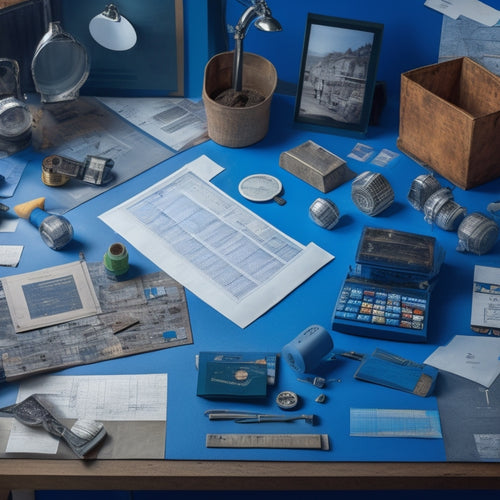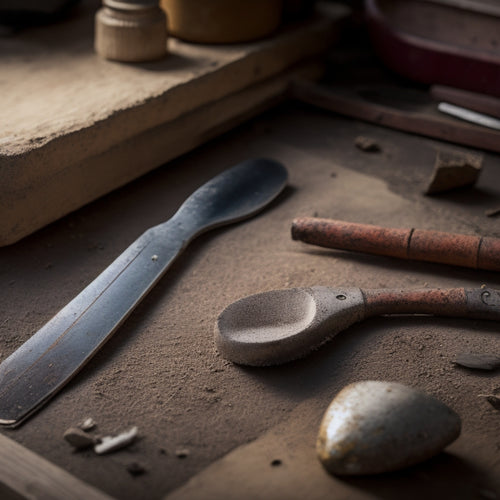
3 Best Power Tools for Garage Renovation Success
Share
To guarantee garage renovation success, you'll want to prioritize three essential power tools: a cordless drill for versatility in drilling pilot holes and driving screws, an impact driver for high-torque output on large screws and lag bolts, and a circular saw for precise cross-cuts and rip cuts in lumber. With these tools, you'll be well-equipped to tackle most tasks efficiently. As you move forward, you'll uncover more nuances in garage renovation, such as the importance of battery type, voltage, and Ah rating, as well as the role of sanding and finishing techniques in achieving a professional-grade finish.
Key Takeaways
• Invest in a cordless drill for versatility in drilling pilot holes and driving screws during garage renovation.
• An impact driver is essential for high-torque output and efficiency with large screws, lag bolts, and nuts.
• A circular saw is ideal for making precise cross-cuts and rip cuts in lumber, a crucial task in garage renovation.
• Consider a high-quality sander for smoothing out rough surfaces and imperfections in wood, ensuring a professional finish.
• Choose a power tool with a lithium-ion battery for long cycle life, fast charging, and reliable performance throughout the renovation process.
Essential Drilling and Driving Tools
When renovating your garage, you'll need a reliable drill and driver combo to tackle tasks like drilling pilot holes, driving screws, and mixing materials. A cordless drill is a must-have for its versatility and convenience.
Look for one with a high torque rating and adjustable speed settings to handle various tasks. For heavy-duty applications, an impact driver is essential. Its high-torque output makes it perfect for driving large screws, lag bolts, and nuts.
When choosing a cordless drill and impact driver combo, consider the battery type, voltage, and ampere-hours (Ah). Lithium-ion batteries are popular for their long cycle life and fast charging times.
A higher voltage (18V or 20V) and higher Ah rating (4Ah or 5Ah) typically translate to more power and longer runtime. Additionally, look for features like built-in LED lights, belt clips, and adjustable torque settings to enhance your workflow.
With the right cordless drill and impact driver combo, you'll be well-equipped to tackle drilling and driving tasks in your garage renovation project.
Cutting and Shaping Masterpieces
You'll need a reliable set of cutting and shaping power tools to transform raw materials into functional components and decorative elements for your garage renovation.
When it comes to woodworking techniques, a circular saw is a must-have for making precise cross-cuts and rip cuts in lumber. A jigsaw, on the other hand, excels at curved cuts and intricate designs. For material selection, consider a reciprocating saw for demo work and pruning thick branches. A miter saw is also essential for making precise angled cuts in wood, ensuring a professional finish.
As you work with various materials, a bandsaw will help you navigate complex curves and irregular shapes. For smaller, more delicate tasks, a rotary tool with interchangeable bits is perfect for carving, engraving, and detail work.
Don't forget a router, which will help you create decorative edges, profiles, and joinery. With these cutting and shaping power tools in your arsenal, you'll be well-equipped to tackle any woodworking project that comes your way, and your garage renovation will be a masterpiece.
Sanding and Finishing Touches
With your cutting and shaping tasks complete, it's time to turn your attention to smoothing out rough edges and adding the final flourishes to your garage renovation project.
Sanding is an essential step in achieving a professional-looking finish, and having the right tools and techniques makes all the difference. You'll want to invest in a high-quality sander, such as a belt sander or orbital sander, to tackle rough surfaces and remove imperfections. Mastering various sanding techniques, like using progressively finer grits and working with the wood grain, will help you achieve a silky smooth finish.
Once you've sanded to perfection, it's time to apply your chosen finishing products. From stains and sealers to polyurethanes and waxes, the right finish can elevate your project from good to great. Be sure to choose products compatible with your materials and follow the manufacturer's instructions for application and drying times.
With patience and practice, you'll be able to achieve a stunning finish that showcases your hard work and attention to detail. By combining the right sanding techniques with high-quality finishing products, you'll be able to add the perfect finishing touches to your garage renovation project.
Frequently Asked Questions
Can I Use Power Tools in a Garage With Low Ceilings?
When working in a garage with low ceilings, you'll want to contemplate the height of your power tools to avoid any obstacles.
Look for compact tool options that are designed with low ceiling considerations in mind.
Many manufacturers offer shorter or foldable tools that can help you navigate tight spaces.
You'll be able to work efficiently and safely, even in cramped areas.
How Do I Protect My Floors From Power Tool Damage?
When working on your garage renovation, you'll want to prioritize damage prevention to protect your floors.
Start by covering them with durable floor coverings like drop cloths or plastic sheets. This will create a barrier between your floors and potential debris or spills.
Additionally, consider using floor mats with non-slip surfaces to prevent tools from slipping and scratching the floor.
Are Power Tools Safe to Use in a Garage With Kids?
When working with power tools in a garage where kids are present, you must prioritize power tool safety.
You're responsible for ensuring child supervision, so designate a kid-free zone around your workspace. Set clear boundaries and educate your kids about the dangers of power tools.
Always unplug tools when not in use, and store them out of reach.
Can I Share Power Tools With Friends or Neighbors?
You're like a master chef, guarding your prized recipes - but should you share your power tools with friends or neighbors?
Establishing tool sharing etiquette is key. Consider a neighborhood tool exchange, where you can swap tools and expertise.
Just make certain you're clear on usage guidelines, maintenance, and return expectations. This way, you'll foster a sense of community and avoid any 'borrowing' miscommunications.
Do I Need a Dedicated Power Outlet for Each Tool?
When setting up your workspace, you'll need to contemplate the power outlet types and tool power requirements.
You can't just plug everything into a single outlet, as it may overload and cause safety issues.
Check each tool's manual for its specific power needs, then plan your outlets accordingly.
You may need dedicated 15-amp or 20-amp outlets for heavier tools, while lighter ones can share a standard 15-amp outlet.
Conclusion
You've got the right tools to transform your garage into a stunning space.
Don't let concerns about 'not being handy' hold you back - with these three power tools, you'll be well on your way to a successful renovation.
Remember, it's not about being a pro, it's about having the right equipment and a willingness to learn.
Get started, and you'll be amazed at what you can create!
Related Posts
-

5 Best Home Renovation Project Timeline Checklists
You're looking for a clear understanding of the timeline for your home renovation project. A good place to start is w...
-

Why Inspect Stucco Repair Equipment Before Renovation
When starting a stucco repair renovation, you need to inspect your equipment to prevent accidents, save time and mone...
-

3 Best Planter Shopping Timeline Tips for Renovators
When incorporating planters into your renovation project, you'll want to plan carefully to avoid delays and guarantee...


